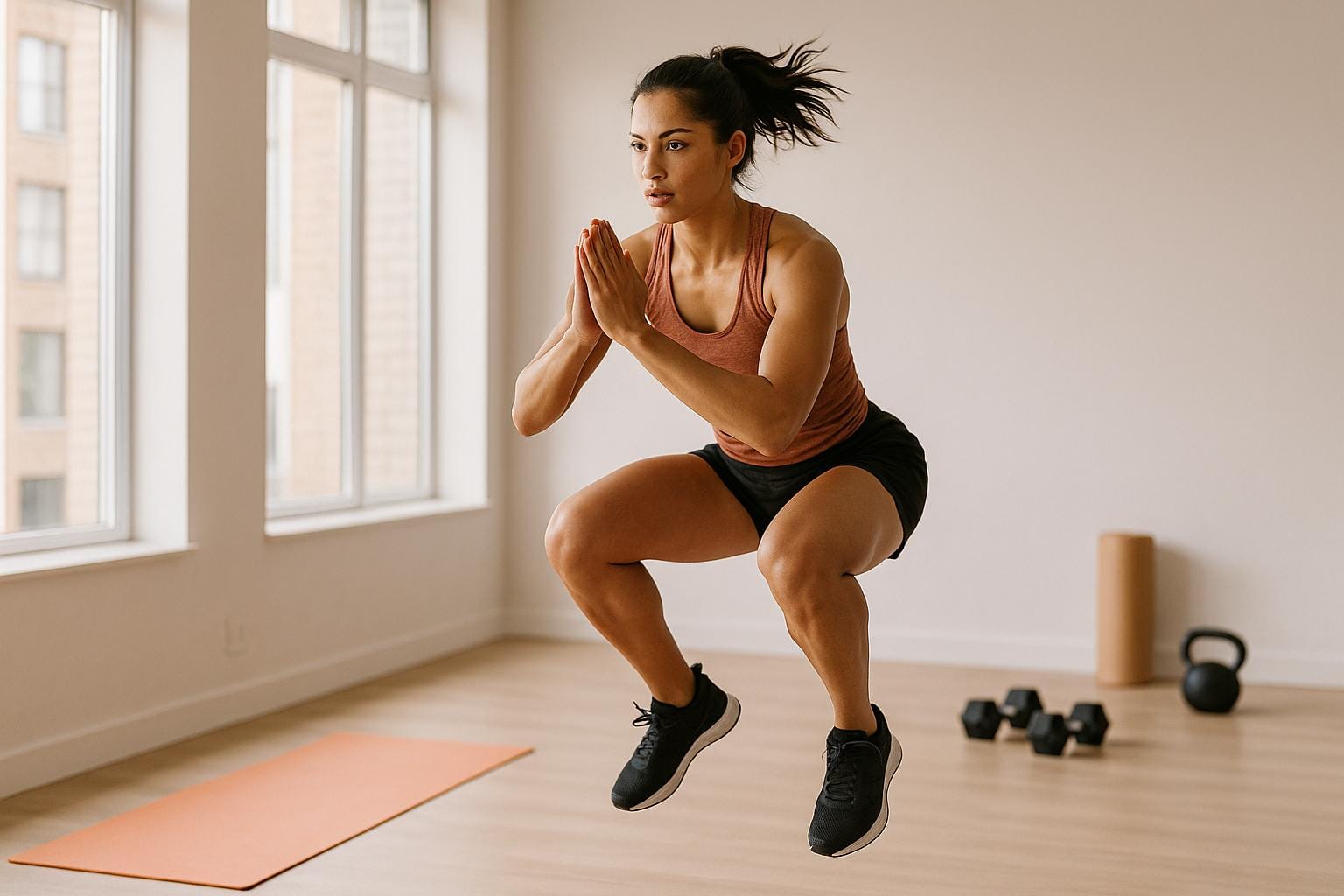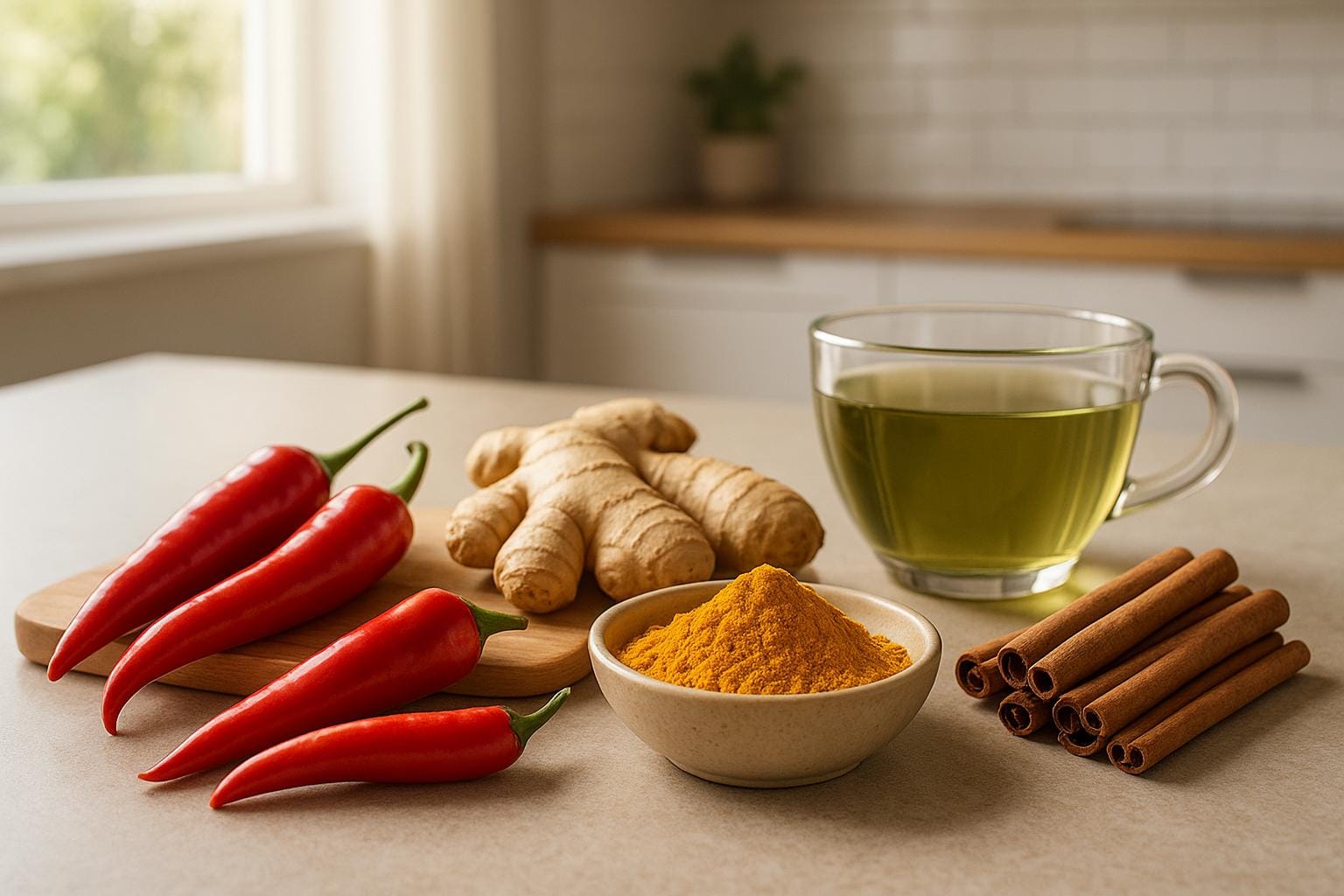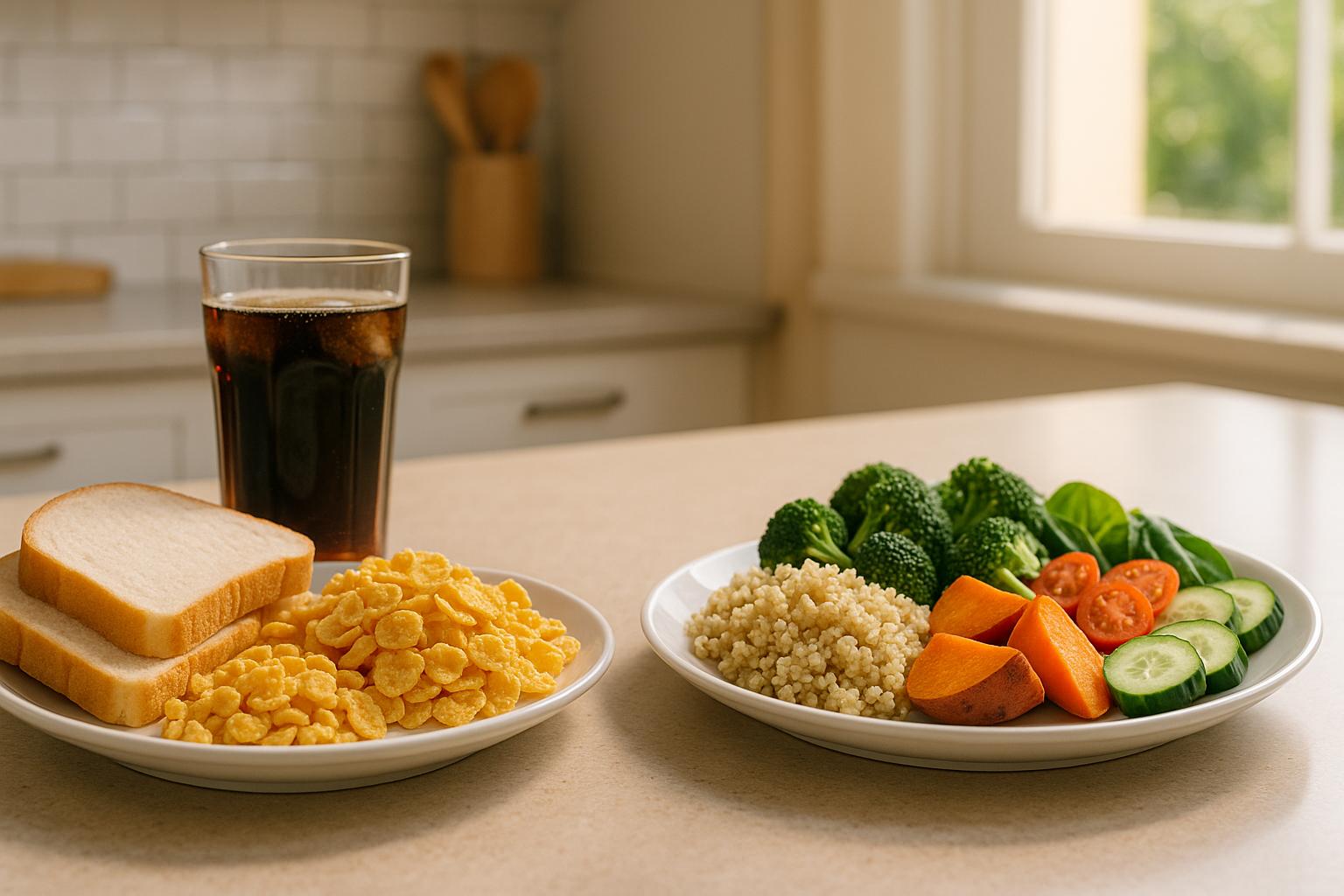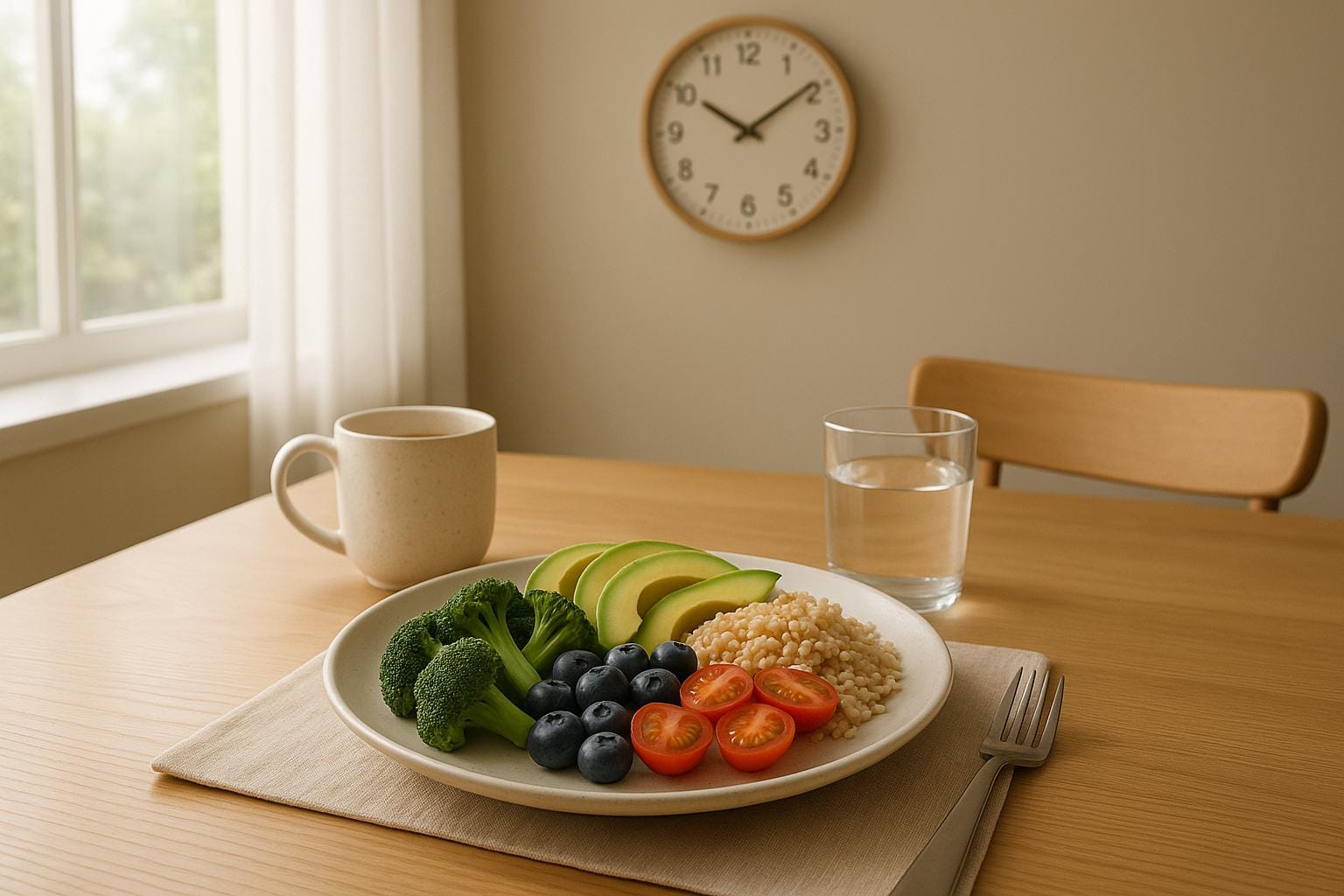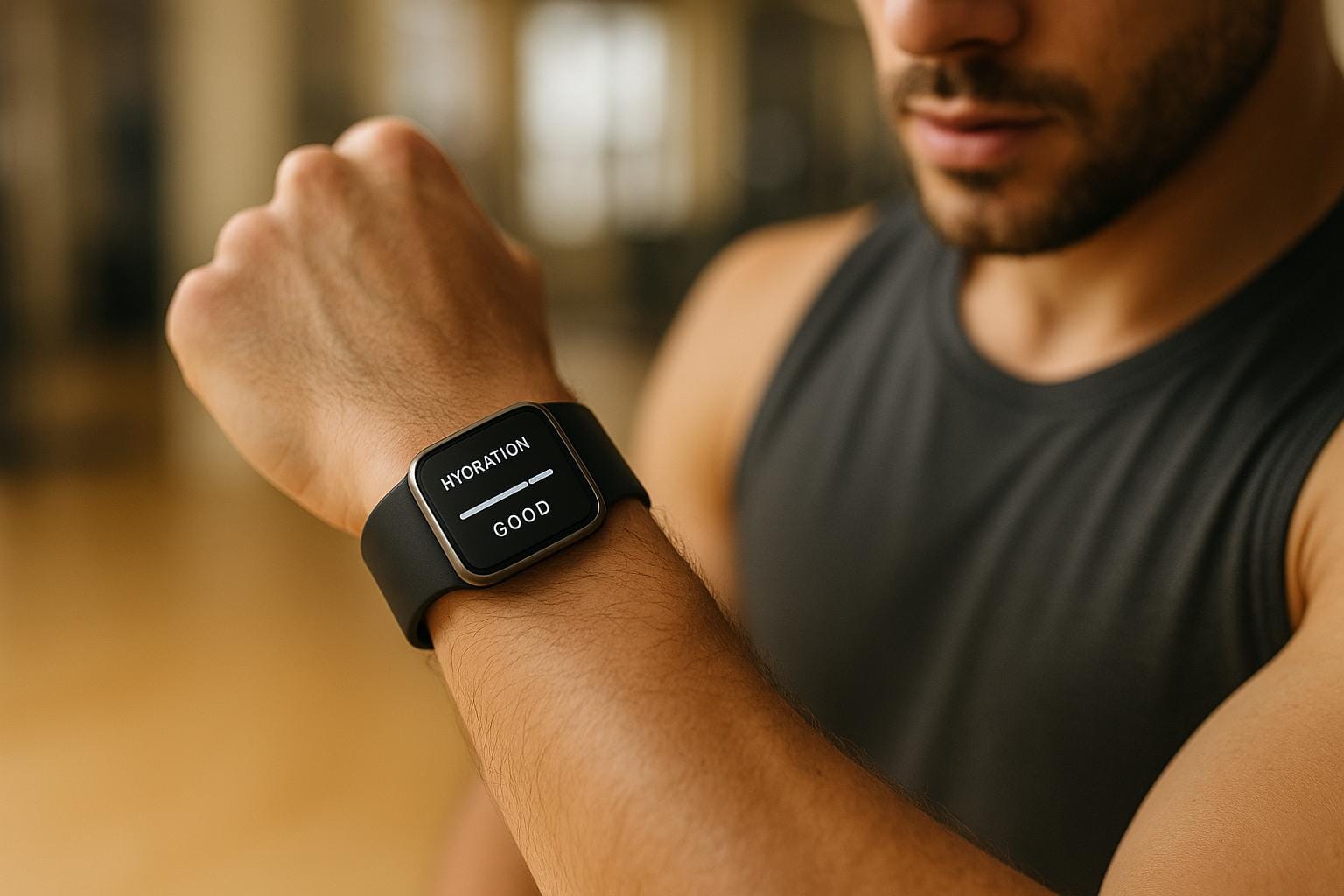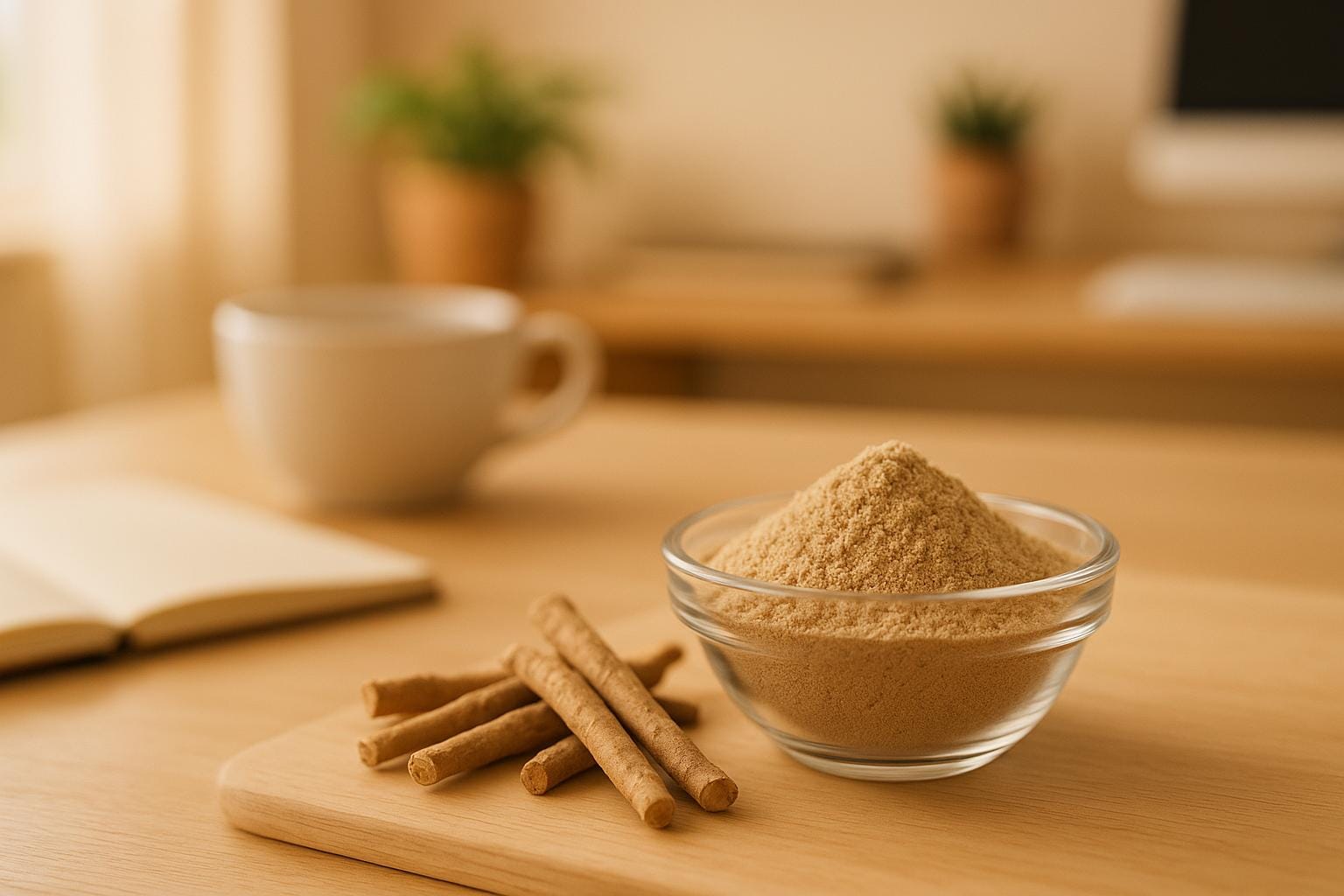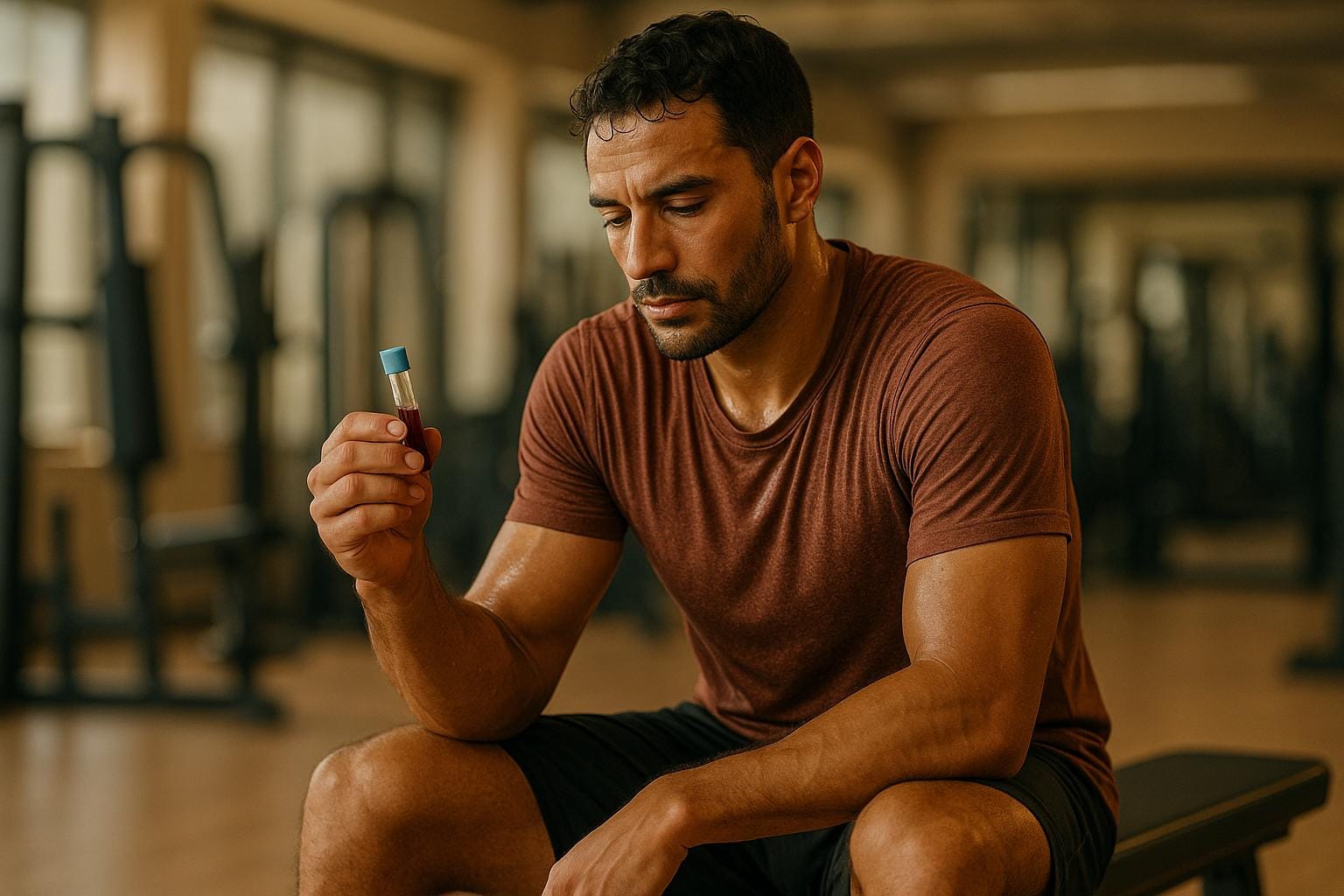When you're short on time, 10-minute HIIT workouts can deliver big fitness results. These routines combine intense exercise bursts with short rest periods, offering the same benefits as longer workouts. Here's why they work and how to get started:
- Save Time: Just 10 minutes of HIIT can match the results of 50 minutes of traditional cardio.
- Health Benefits: Boost heart health, burn calories, and improve endurance.
- No Equipment Needed: Many routines only require your body weight and a timer.
- Adaptable for All Levels: Modify exercises to suit beginners or challenge advanced athletes.
- Mood Booster: Quick sessions can improve mental health and reduce stress.
Quick Workout Examples:
- Bodyweight Circuit: Squats, push-ups, burpees.
- Tabata: 20 seconds of work, 10 seconds rest (e.g., mountain climbers).
- EMOM: "Every Minute On the Minute" with squats and lunges.
- Core Focus: Planks, crunches, and leg raises.
- Cardio Sprints: Short, high-intensity bursts of running or cycling.
These workouts are easy to fit into your schedule, whether you're at home, in the office, or traveling. Start with 2–3 sessions a week and build up as you progress. Always prioritize proper form and consult a healthcare professional if you're new to exercise or have existing conditions.
10 MIN CARDIO HIIT WORKOUT - ALL STANDING - Full Body, No Equipment, No Repeats
1. Bodyweight HIIT Circuit
Bodyweight HIIT circuits are perfect for when you don’t have access to a gym or equipment. This routine is one of many efficient options for squeezing in a workout on a busy day.
Time Efficiency (10 Minutes)
These circuits pack a punch in just 10 minutes. They combine high-intensity exercises with short recovery periods, giving you a full-body workout that keeps your heart rate up and your form sharp. It's a quick yet effective way to stay active.
Exercise Variety (Targeting Multiple Muscle Groups)
A good bodyweight circuit ensures you’re working all the major muscle groups. Here’s how the exercises break down:
- Mountain climbers: Engage your shoulders, chest, abs, glutes, and legs.
- Push-ups: Focus on your chest, triceps, upper back, and shoulders.
- Squats: Strengthen your quadriceps, hamstrings, and glutes.
- Jump lunges: Activate your glutes, quads, hamstrings, and calves.
- Burpees: Provide a full-body challenge, targeting your chest, shoulders, triceps, core, quads, and glutes.
This variety ensures you’re engaging multiple muscles while making the most of your limited workout time.
Scalability (For All Fitness Levels)
No matter your fitness level, this circuit can be adjusted to suit your needs.
- For beginners: Try kneeling push-ups, burpees without the push-up, or alternating lunges instead of jump lunges.
- For advanced participants: Add clapping push-ups, full burpees with jumps and push-ups, single-leg Bulgarian squats, or mountain climbers with twists.
"How I've always explained HIIT to my clients is that you're going to do a moment of really intense work followed by some rest. It's not just high intensity the entire time." - Angela Gargano, CPT
Equipment Needs (Minimal or None)
All you need is your body weight, a timer, and enough room to move. These workouts fit seamlessly into your schedule, wherever you are.
"Here are 3 short but effective workouts to try. You can do them anywhere. And you don't need any fancy exercise equipment. All you need is a timer and space to move." - Kaiser Permanente
Quick Form Tips for Best Results
- Squats: Keep your back straight and hinge at the hips.
- Lunges: Ensure your hips stay squared forward, avoiding any side sway of your lead leg.
This article is for informational purposes only and is not intended as medical advice. Please consult a healthcare professional before starting any new fitness or wellness routine.
2. Tabata Blast
Tabata takes high-intensity interval training (HIIT) to the next level with its structured format, delivering impressive results in just four minutes. It's a perfect fit for those tight on time, offering an efficient workout option for even the busiest days.
Time Efficiency (10 Minutes)
A single Tabata round consists of 8 cycles of 20 seconds of effort followed by 10 seconds of rest, adding up to just 4 minutes. In a 10-minute session, you can fit in two rounds, including a quick warm-up and cool-down.
"At only four minutes, Tabata may be the shortest workout you'll ever do. But make no mistake, you'll feel the burn each and every second." - Lauren Bedosky, Author
This high-intensity approach delivers impressive calorie burn. According to ACE research, Tabata burns an average of 15 calories per minute. Additionally, original studies revealed a 15% boost in VO₂ max and a 28% increase in anaerobic fitness, outperforming moderate exercise, which showed no such improvements.
Exercise Variety (Targeting Different Muscle Groups)
With Tabata, you can mix and match explosive exercises that engage multiple muscle groups. Moves like burpees, squat jumps, push-ups, and mountain climbers are all excellent choices for this format.
For example, Jim Stoppani's Tabata Weight Blast program integrates 2-4 exercises per muscle group. Participants are encouraged to increase weights or reps weekly over a 3-6 week period, keeping the workout both challenging and dynamic.
Scalability (Beginner to Advanced Modifications)
One of Tabata's strengths is its flexibility. Whether you're new to fitness or a seasoned athlete, it can be adjusted to suit your level. Beginners can modify exercises or extend rest periods, as shown by Genesis Health Clubs:
| Fitness Level | Exercise Examples |
|---|---|
| Beginner | Burpee without push-up, Kneeling push-ups |
| Intermediate | Burpee with push-up, Regular push-up, Jump Lunge |
| Advanced | Full burpee with jump, Navy Seal push-up |
For those just starting, try a modified Tabata routine: complete five or six rounds of 20 seconds of work with 40 seconds of rest. Begin with one session per week, gradually building up to the traditional Tabata timing as your fitness improves.
"A Tabata workout for the general public looks very different from the original Tabata, which was studied on high-performance athletes." - Mindy Pedersen, ACE-certified group fitness trainer
Equipment Needs (Minimal or Optional Equipment)
Tabata sessions are simple to set up and require minimal equipment. In fact, all you need is your body weight and a timer. You can do an effective Tabata workout just about anywhere - whether it's your living room, a hotel room, or your backyard.
To avoid overtraining, limit Tabata workouts to three times per week.
This article is for informational purposes only and is not intended as medical advice. Please consult a healthcare professional before starting any new fitness or wellness routine.
3. EMOM Strength and Cardio
In our ongoing exploration of 10-minute HIIT workouts, EMOM routines bring a fresh twist by blending strength and cardio with precision timing. EMOM stands for "Every Minute On the Minute", where you perform a set exercise or series of movements at the start of each minute. The remaining time in that minute becomes your rest period before diving into the next round.
Time Efficiency (10 Minutes)
EMOM workouts are a powerhouse of efficiency, packing a full-body workout into just 10 minutes. These sessions challenge your cardiovascular endurance and muscular strength simultaneously, keeping your heart rate elevated throughout the routine.
"The heart rate will remain elevated throughout the workout, even during rest breaks. This helps to improve cardiovascular endurance, increase heart efficiency, and enhance overall aerobic capacity over time." – Christine Mara, PT, DPT, LAT, ATC, a Board-Certified Sports Clinical Specialist
A study in the Journal of Physical Education and Sport highlights that EMOM training can temporarily boost strength, endurance, cardiovascular fitness, and speed in runners. Plus, the interval nature of EMOM workouts triggers post-exercise oxygen consumption (EPOC), which means your body keeps burning calories at an increased rate even after you’re done.
Exercise Variety (Targeting Different Muscle Groups)
One of the standout features of EMOM workouts is their adaptability to target various muscle groups. A beginner-friendly 10-minute routine might alternate between 10 bodyweight squats in the first minute and 5 push-ups in the second, cycling through this pattern for the entire session.
For those looking to up the intensity, an intermediate version could include 15 kettlebell swings in one minute, followed by 10 jumping lunges in the next. Advanced athletes might tackle 10 heavy deadlifts in the first minute and 15 box jumps in the second during a longer 20-minute session.
Scalability (Beginner to Advanced Modifications)
EMOM routines shine in their ability to cater to all fitness levels. Beginners can stick with simple bodyweight exercises and fewer reps, while seasoned athletes can push themselves with heavier weights and more complex movements. Progression is straightforward - add more reps, increase weights, or extend the workout duration as your fitness improves.
As Alexander Rothstein, coordinator and instructor for the Exercise Science program at the New York Institute of Technology, notes:
"Every minute on the minute is a form of interval training that allows individuals to balance between faster repetitions (more intensity) and longer rest periods."
Equipment Needs (Minimal or Optional Equipment)
Another advantage of EMOM workouts is their flexibility when it comes to equipment. Many routines rely solely on bodyweight exercises, making them ideal for home or travel workouts. For example, a 12-minute beginner EMOM could include 10 push-ups, 10 squats, 15 bicycle crunches, and 12 jumping jacks, repeated three times.
If you’re looking to switch things up, optional equipment like resistance bands, dumbbells, or kettlebells can add variety and intensity. The key is to tailor the exercises to your fitness level and focus on the muscle groups you want to train.
This article is for informational purposes only and is not intended as medical advice. Please consult a healthcare professional before starting any new fitness or wellness routine.
4. Lower Body Workout
This lower body workout is designed to build leg strength and explosiveness, all within a short 10-minute HIIT routine. Even on the busiest days, this approach engages your glutes, quads, hamstrings, and calves while delivering both strength and cardio benefits.
Time Efficiency (10 Minutes)
A 10-minute lower body HIIT workout can pack a punch when structured effectively. Using a three-to-one work-to-rest ratio, you'll push hard during active intervals and recover just enough to maintain intensity throughout the session. This balance ensures you maximize results without burning out too quickly.
Mark Beier, Co-director of Training at Shred415 in Chicago, offers an excellent example of this efficiency. His routine combines strength-building moves like walking lunges and squats with explosive plyometric exercises such as jumping lunges and jumping squats.
"In this workout, strength exercises, like the walking lunges and squats, as well as plyometric exercises, like jumping lunges and jumping squats, work both legs strength and explosiveness in the 10-minute time frame... When combined with the running intervals, this type of workout will surely elevate your resting heart rate post-workout for a major caloric burn." – Mark Beier, Co-director of Training at Shred415
Exercise Variety (Targeting Different Muscle Groups)
This workout is designed to hit multiple lower-body muscles using a mix of compound and explosive movements. These dynamic exercises not only build strength but also elevate your heart rate quickly, making them highly effective for functional fitness.
Some key moves include:
- Squat jumps: Engage glutes, quads, and calves.
- Alternating jump lunges: Strengthen quads, glutes, and hamstrings while improving balance.
- Single-leg Romanian deadlifts: Focus on the posterior chain and enhance stability.
- Lateral jumps: Target the outer thighs.
- High knees: Activate hip flexors.
- Mountain climbers (plank position): Combine lower-body work with core stabilization.
Scalability (Beginner to Advanced Modifications)
One of the best things about lower body HIIT is how easily it can be adjusted for any fitness level. Beginners can start with simpler variations, focusing on form and control. For example, swap squat jumps for bodyweight squats or replace jumping lunges with reverse lunges. You can also reduce the range of motion or use a chair for extra support.
Intermediate participants can step up the challenge by adding dumbbells to walking lunges or trying Bulgarian split squats. Advanced athletes, on the other hand, might incorporate weighted movements, increase their range of motion, or experiment with exercises like single-leg hip thrusts or barbell front squats.
Personal trainer Keith Hodges captures the essence of this workout's adaptability:
"By combining these leg strengthening exercises with plyometrics, you'll push your legs and cardiovascular system past the point of exhaustion. All it takes is all you've got for 10 minutes!" – Keith Hodges, Personal Trainer and Owner of Mind in Muscle
Equipment Needs (Minimal or Optional Equipment)
This routine is incredibly versatile, requiring little to no equipment. Many exercises, such as squats, lunges, glute bridges, and plyometric moves, can be done using just your body weight.
If you want to increase the challenge, minimal equipment can add variety. For example, dumbbells can turn basic lunges into walking lunges or add resistance to Romanian deadlifts. A sturdy step or box can be used for step-ups, while resistance bands are great for lateral movements and glute activation.
This flexibility means you can perform the workout anywhere - whether at home or in the gym. Begin with bodyweight exercises to perfect your form, then incorporate equipment as you build strength and confidence.
This article is for informational purposes only and is not intended as medical advice. Please consult a healthcare professional before starting any new fitness or wellness routine.
5. Upper Body Power Moves
This 10-minute upper body HIIT routine is designed to build both strength and endurance, targeting your chest, shoulders, back, arms, and core. Whether you’re squeezing in a quick session between meetings or looking for an energy boost, these exercises will push your upper body while keeping your heart rate high. It’s a great addition to a full-body HIIT series, focusing on developing strength in key upper body areas.
Time Efficiency (10 Minutes)
A well-planned 10-minute upper body HIIT workout can hit all major muscle groups through smart exercise choices and timing. The secret is combining compound movements, which engage multiple muscles at once, with isolation exercises that zero in on specific areas like your biceps and triceps.
Set a timer for 60-second intervals per exercise to balance intensity and form. Include moves like push-ups, planks, jump rope, triceps dips, bicep curls with resistance bands, and barbell overhead presses. This structure ensures you’re working every major upper body muscle group while staying within the time limit.
By mixing up the exercises, you keep your muscles guessing and your heart rate up. The transitions between movements allow specific muscle groups to recover briefly while keeping the workout dynamic and engaging.
Exercise Variety (Targeting Different Muscle Groups)
Upper body HIIT routines shine because they combine compound and isolation exercises for well-rounded muscle engagement. Push-ups are a staple, working your chest, shoulders, triceps, back, and core all at once. Meanwhile, focused moves like bicep curls help develop specific areas, and Arnold presses strengthen your shoulders.
| Exercise | Target Muscles |
|---|---|
| Push-ups | Chest, shoulders, triceps, back, core |
| Bicep Curls | Biceps |
| Arnold Press | Shoulders (deltoids) |
| Back Rows | Back (latissimus dorsi) |
| Skull Crushers | Triceps |
| Triceps Dips | Triceps |
| Barbell Overhead Press | Shoulders, triceps |
| Plank | Core, shoulders |
This variety ensures balanced muscle development. Compound exercises like push-ups and overhead presses build functional strength, while isolation moves like skull crushers and bicep curls target specific muscles for improved definition or strength.
Scalability (Beginner to Advanced Modifications)
One of the best things about upper body HIIT is how easily it can be adjusted to fit any fitness level. Beginners should focus on mastering proper form before increasing intensity or adding weights. Modifications make it easier to ease into the routine.
For example, beginners can start with wall push-ups or knee push-ups before transitioning to standard push-ups. If a movement feels too challenging, reducing the range of motion is an effective way to build strength gradually while maintaining proper technique. Shape Magazine’s January 2024 issue suggests beginners stick to 45- to 75-second intervals per exercise to allow time for learning the movements and building confidence.
For advanced athletes, the challenge can be increased by adding weights, expanding the range of motion, or incorporating explosive movements. Regardless of fitness level, the golden rule is always the same: focus on quality over quantity. As Chris Ryan, C.S.C.S., puts it:
"Less is more, and listen to your body" - Chris Ryan, C.S.C.S.
This flexibility makes upper body HIIT an effective option for anyone, from fitness newcomers to seasoned athletes.
Equipment Needs (Minimal or Optional Equipment)
One of the biggest advantages of upper body HIIT is that it requires little to no equipment. This makes it ideal for home workouts or when you’re on the go. Bodyweight exercises like push-ups, planks, burpees, and mountain climbers are more than enough to deliver a complete strength and cardio session.
"If you're willing to work out, you can find a way" - Chris Dempers, ACSM EP-C, Exercise Physiologist, Cleveland Clinic
As you progress, you can add resistance bands, dumbbells, or kettlebells to increase the challenge. Resistance bands, in particular, are a budget-friendly and space-saving alternative to traditional weights, offering similar strength-building benefits. For more variety, advanced equipment like pull-up bars can be introduced down the line.
Start with bodyweight exercises to establish proper form and build a strong foundation. Then, gradually incorporate resistance bands or light weights as you advance. This step-by-step approach allows you to build a functional home gym over time while ensuring that every piece of equipment adds value to your fitness journey.
This article is for informational purposes only and is not intended as medical advice. Please consult a healthcare professional before starting any new fitness or wellness routine.
6. Core Training Routine
A quick yet effective 10-minute core HIIT routine can help strengthen your midsection, burn calories, and improve overall endurance. By combining dynamic movements with stability exercises, this approach keeps your heart rate high while effectively targeting your core.
Time Efficiency (10 Minutes)
One of the best things about a core HIIT workout is how it maximizes results in a short amount of time. By engaging multiple muscle groups at once and incorporating both movement and anti-movement patterns, you can achieve a full core workout in just 10 minutes. Mark Beier, co-director of training at Shred415, designed a routine that demonstrates this perfectly. It includes high knees and football shuffles to keep your heart rate up while working your core muscles.
"This ab workout uses multi-plane movements to hit each area of the core in 10 minutes. The HIIT aspect of the high knees and football shuffles get the heart rate up while still utilizing the core muscles to perform those exercises." – Mark Beier, co-director of training at Shred415
To get the most out of your workout, sync your breathing with your movements. Exhaling during exertion helps intensify core engagement.
Exercise Variety (Targeting Different Muscle Groups)
A well-rounded core routine incorporates a mix of movements, including rotation, anti-rotation, flexion, extension, lateral flexion, and anti-lateral flexion. For exercises like crunches or leg raises, focus on pressing your lower back into the floor to properly activate your transverse abdominis and rectus abdominis. When performing standing exercises, keep a neutral spine to allow your core to stabilize effectively.
"When you inhale, your ribcage opens up, and when you exhale, you can close the ribcage, engage the diaphragm, and pull those central tendons down into the core." – Alicia Jamison, C.P.T., trainer at Bodyspace Fitness
This variety ensures that every part of your core gets the attention it needs.
Scalability (Beginner to Advanced Modifications)
Whether you're a beginner or a seasoned athlete, a core HIIT routine can be adjusted to suit your fitness level.
- Beginners: Start with foundational moves like bridges, standard crunches, or modified planks with knees on the floor.
- Intermediate: Progress to exercises such as warrior crunches, bird dog with elbow to knee, or full plank variations.
- Advanced: Take on high-intensity moves like mountain climbers, side planks with rotation, or Turkish get-ups.
Marvin Burton, head of fitness at Anytime Fitness UK, highlights the importance of focusing on quality over duration:
"People think that because they can do a core exercise for a long period of time they've got a strong core, but what's the benefit of holding a plank for two minutes? I don't see the point because you're just getting good at doing something for longer. Whereas, when you start adding weight and resistance you find they can only do it for a short period of time. [It's beneficial] because you're gonna have to recruit more muscle fibres to then control that movement." – Marvin Burton, head of fitness at Anytime Fitness UK
The key is to maintain proper form and stability, then gradually increase the challenge by adding resistance, using unstable surfaces, or expanding your range of motion.
Equipment Needs (Minimal or Optional Equipment)
The beauty of core HIIT is that you don’t need any equipment - your bodyweight alone is enough to get an effective workout. Bodyweight exercises naturally engage your core throughout the movements, making them ideal for this type of routine. You can adjust the difficulty by changing your rep count, tempo, or exercise variations.
"One of the most efficient ways to burn plenty of calories with bodyweight exercises is through high-intensity interval training (HIIT), which involves doing intervals alternating between bouts of high-intensity exercise and rest. This not only helps you burn calories during a workout but also creates an afterburn effect post-workout." – Noam Tamir, C.S.C.S. and founder and CEO of TS Fitness
For those ready to take it up a notch, resistance bands or light weights can add extra intensity. Marvin Burton also suggests incorporating standing exercises, as they engage more joints and better simulate real-life movements compared to floor-based exercises.
This article is for informational purposes only and is not intended as medical advice. Please consult a healthcare professional before starting any new fitness or wellness routine.
7. Cardio Sprint Intervals
Cardio sprint intervals are a powerhouse workout, combining bursts of maximum effort with short recovery periods. They’re a fantastic way to maximize fat-burning and cardiovascular fitness in a fraction of the time traditional cardio requires - perfect for anyone with a packed schedule.
Time Efficiency (10 Minutes)
Here’s the deal: you don’t need an hour to see results. Research shows that a 10-minute workout featuring just 1 minute of intense effort can match the benefits of a much longer moderate workout. That’s the beauty of sprint intervals - they pack a punch in minimal time.
A meta-analysis from RunRepeat looked at over 70 studies and found that sprint interval training reduced body fat percentage by nearly 40% more than traditional HIIT, all while requiring 60% less time. If you’re short on time but big on goals, sprint intervals are a game-changer.
Exercise Variety (Targeting Different Muscle Groups)
Sprint intervals aren’t limited to running - they’re incredibly versatile. You can mix it up with exercises like burpees (which can spike your heart rate to an average of 170 BPM, similar to an all-out sprint), mountain climbers, squat jumps, jump rope, cycling, swimming, or rowing.
For example, cyclists can alternate 1 minute of intense pedaling with 1 minute of light recovery, repeating this cycle five times for a complete workout.
"Sprints can be a really effective way to improve your cardiovascular fitness, strength and power, and running economy. You can gain bigger improvements and in less time with sprinting than with continuous easy running!" – Charlotte Arter, British Distance Athlete.
No matter your preferred activity, sprint intervals can be tailored to suit your fitness level and goals.
Scalability (Beginner to Advanced Modifications)
Sprint intervals are easily adjustable, making them suitable for everyone from beginners to seasoned athletes. The difference lies in how long you sprint, how much recovery you take, and how intense you go.
Beginner-friendly plan:
Start slow and steady with 10-second sprints followed by 3 minutes of recovery. Over eight weeks, you can gradually increase the sprint duration:
- Weeks 1–2: 4 sprints of 10 seconds each
- Weeks 3–4: Extend to 15-second sprints
- Weeks 5–6: Push to 20-second sprints
- Weeks 7–8: Work up to 25-second sprints
Beginners should aim for 80–90% of their maximum effort at first, rather than going all-out.
Advanced plan:
For experienced individuals, try 4 sets of 25-second all-out sprints with 2-minute recovery periods, twice a week. As you improve, you can add more sprints, extend the duration to 30 seconds, or reduce recovery time to 1.5 minutes or less.
The goal is to focus on giving your best effort during each sprint, rather than obsessing over exact timing.
Equipment Needs (Minimal or Optional Equipment)
One of the best things about sprint intervals? You don’t need fancy equipment or a gym membership. You can do them almost anywhere - on a track, trail, hill, road, or even in your living room. If you prefer a controlled environment, a treadmill works too, but it’s not essential.
For home workouts, exercises like burpees, mountain climbers, and running in place can deliver the same cardiovascular benefits as traditional sprints. All you need is the determination to push hard during each intense burst. This simplicity makes sprint intervals an easy addition to any routine.
This article is for informational purposes only and is not intended as medical advice. Please consult a healthcare professional before starting any new fitness or wellness routine.
8. Low-Impact HIIT for Recovery
When it comes to quick and effective workouts, low-impact HIIT routines stand out as a fantastic option for recovery and joint-friendly training. These workouts are designed to minimize stress on your joints while still delivering a solid cardiovascular challenge. As Aimee Layton, Ph.D., puts it:
"Low impact means you're not putting a lot of force on your joints."
This makes low-impact HIIT a great choice for those with joint concerns, arthritis, or anyone easing into a fitness routine and looking to build strength gradually.
Time Efficiency in Just 10 Minutes
A 10-minute low-impact HIIT session can pack a punch without overwhelming your body. Adjusting the work-to-rest ratio allows you to maintain intensity while keeping things joint-friendly. For instance, beginners might start with shorter bursts of exercise followed by longer rest periods, giving their bodies time to adapt.
A Variety of Joint-Friendly Exercises
Low-impact HIIT doesn’t skimp on variety. You can choose from exercises that engage different muscle groups while being gentle on your joints. Here are a few options:
- Marching in place: Lift your knees high and swing your arms to elevate your heart rate.
- Step jacks with arm raises: Replace jumping jacks by stepping out to the side and raising your arms overhead.
- Simulated jump rope: Perform controlled arm circles and light hops to mimic jump rope movements.
- Squats with arm raises: Combine squats with arm lifts to engage your glutes, quads, and shoulders.
- Front kick lunges: Pair a front kick with a reverse lunge to work your hamstrings and glutes.
- Lateral lunges: Step to the side to target your thighs, glutes, and core.
- Core-focused moves: Exercises like bicycle crunches, the dead bug, and bear crawls help improve stability and coordination.
Scalable for All Fitness Levels
Low-impact HIIT is incredibly adaptable, making it suitable for everyone from beginners to advanced exercisers. If you’re just starting out, try 20 seconds of activity followed by 40 seconds of rest. For those managing joint pain, even gentler movements like cycling or swimming-inspired exercises can be effective. As your fitness improves, you can gradually increase the workout intervals and reduce rest time - just make sure to prioritize proper form.
Minimal Equipment Required
The beauty of low-impact HIIT is that it doesn’t require much equipment. Bodyweight exercises like squats, lunges, push-ups, and planks are more than enough to get started. If you want to mix things up without adding stress to your joints, try using resistance bands or light dumbbells. Equipment like an exercise bike, rowing machine, or treadmill also offers excellent low-impact alternatives. Whatever you choose, keep your movements controlled and precise.
This style of HIIT is a perfect recovery-focused option, offering a gentle yet effective way to stay active while giving your joints a break. It’s a seamless addition to any time-efficient fitness routine.
This article is for informational purposes only and is not intended as medical advice. Please consult a healthcare professional before starting any new fitness or wellness routine.
9. Sport-Specific HIIT Drills
Sport-specific HIIT drills are designed to mimic the movements and physical demands of your sport, helping you fine-tune your skills while improving overall conditioning. By combining the efficiency of HIIT with sport-specific movements, these drills help you perform better on the field or court.
Time Efficiency (10 Minutes)
A quick 10-minute sport-specific HIIT session can deliver big results by replicating the intensity patterns of gameplay. Take tennis, for example - matches involve short, intense bursts of activity followed by brief recovery periods. HIIT mirrors this stop-and-go rhythm, helping you maintain peak performance during matches.
Angela Gargano, CPT and creator of Strong Feels Good & Pull-up Revolution, highlights the appeal of HIIT:
"It's quick, easy, and effective."
Basketball players, for instance, can benefit from 10-minute sessions that emphasize explosive movements like quick direction changes and powerful jumps. These drills not only mimic in-game actions but also help reduce the risk of injury.
Exercise Variety
Each sport requires its own unique movements, and sport-specific HIIT drills are tailored to target the muscle groups and movement patterns essential for your game. For example:
- Field hockey players can use high-intensity sprints, shuttle runs, and progressive sprints to build speed and endurance.
- Basketball players may focus on plyometric drills to enhance explosive power.
- Tennis players can incorporate lateral lunges and agility drills for improved precision and quick footwork.
These drills are designed to meet the physical demands of your sport, whether it's the explosive power needed on the basketball court or the endurance required on the tennis court.
Scalability
Sport-specific HIIT is highly adaptable, making it suitable for athletes of all fitness levels. Beginners can start with 30 seconds of high-intensity work followed by 1 minute of rest, aiming for 2–3 sessions per week lasting 20–30 minutes total. As fitness improves, intermediate athletes can progress to 2–4 sessions per week of 25–45 minutes each, while advanced athletes might handle 45–60 minute sessions up to 5 times a week.
This gradual progression ensures you continue to challenge your strength and endurance over time. Plus, HIIT helps improve motor unit activation, Type II muscle fiber recruitment, and neuromuscular coordination, which translates to better force production and movement efficiency.
Equipment Needs
One of the best things about sport-specific HIIT is that it often requires minimal equipment, making it perfect for home workouts or when you're on the go. Many drills rely on bodyweight exercises like squats, lunges, and plyometrics that mirror your sport's movements.
If you want to take it up a notch, you can incorporate simple equipment such as:
- Resistance bands: Lightweight and portable, these are great for strength-building.
- Dumbbells and jump ropes: Add intensity and variety to your drills.
- Gym mats: Provide comfort for floor exercises and agility drills.
You can also get creative with items like benches, cones, or walls. For example, tennis players might use a wall for rally practice, while basketball players can set up cones for dribbling drills. These small additions can make your workouts more engaging and effective.
This article is for informational purposes only and is not intended as medical advice. Please consult a healthcare professional before starting any new fitness or wellness routine.
10. Cool-Down and Stretch
After wrapping up a 10-minute HIIT session, it’s important to give your body the chance to wind down properly. A cool-down session not only helps flush out lactic acid but also reduces soreness and kickstarts your recovery process. Think of it as the final touch to your workout, designed to prepare you for your next session while keeping things efficient.
Hannah Corbin, a Peloton cycling instructor, puts it simply:
"The point of a cooldown is to lower your heart rate and to ease your body into a healthy recovery zone."
Time Efficiency
A quick 5–10 minute cool-down paired with 5–7 static stretches can work wonders for recovery and minimizing soreness the next day. Austin Cagley, Peloton's Director of Global Instructor Development, highlights the importance of this:
"A cooldown helps prevent blood pooling in the extremities and promotes the removal of metabolic waste products from your muscles."
Stretching Options
To get the best results, focus on static stretches and hold each position for at least 30 seconds. Here are some effective stretches to include in your routine:
- Cat-Cow: Start on all fours. Alternate between arching your back upward like a cat and dropping your belly downward like a cow. This stretch targets your spine, neck, hips, abs, and back.
- Downward-Facing Dog: A classic yoga pose that stretches your calves, hamstrings, glutes, and both your lower and upper back.
- World's Greatest Stretch: From a lunge position, lower your arms, then rotate your inside arm toward the sky. This move is great for loosening up your hips and legs.
- Figure Four Stretch: Focuses on relieving tension in the hips by targeting the piriformis, iliopsoas muscles, and IT band.
- Seated Forward Fold: Helps lengthen your hamstrings and improve flexibility.
- Seated Spinal Twist: Loosens your lower back muscles and helps relieve stress.
- Child's Pose: A gentle stretch to end your session, sitting back on your heels while extending your arms forward for a full-body release.
Tailoring It to Your Needs
Your cool-down can be as simple or as advanced as you need it to be. If you’re just starting out, focus on basic stretches and hold them for 15–20 seconds, targeting key muscle groups like your hamstrings, quads, and shoulders. As you get more comfortable, extend the hold time to around 30 seconds.
For more experienced individuals, try incorporating deeper stretches like:
- Runner's Lunge with PNF: In a lunge position, press your front leg away with your hand, holding the resistance for several breaths.
- Dynamic Quad Stretch from Lunge: From a low lunge, grab your back foot and gently pull it, alternating between deeper and relaxed stretches.
Always listen to your body and avoid any movements that cause discomfort or pain.
Minimal Equipment Required
The great thing about a cool-down is that it doesn’t require any fancy gear. A yoga mat can add a bit of comfort for floor stretches, and if you want to take it up a notch, tools like a tennis ball or massage ball can help with targeted muscle release (e.g., for your feet or hips).
As you move through each stretch, remember to breathe deeply. This not only helps you relax but also allows you to sink deeper into each stretch.
This article is for informational purposes only and is not intended as medical advice. Please consult a healthcare professional before starting any new fitness or wellness routine.
Conclusion
Adding a 10-minute HIIT workout to your daily routine can change the way you approach fitness without taking up much of your time. Studies show that short, intense bursts of exercise can improve fitness levels nearly as effectively as 50 minutes of traditional cardio.
But it’s not just about saving time. HIIT workouts help maintain a higher metabolic rate long after you’ve finished exercising. They also support fat loss and improve cardiovascular health, especially for individuals managing overweight or obesity. These quick, effective sessions are designed to slot seamlessly into even the busiest schedules.
Knowing you only need 10 minutes makes it easier to overcome the mental hurdle of starting a workout. Plus, these routines are highly adaptable. Beginners can focus on shorter intervals at about 80% effort, with longer recovery periods. If joint pain is a concern, lower-impact options like cycling or swimming are great alternatives. This flexibility means anyone, regardless of fitness level, can work their way toward better health.
Amy Ashmore, a fitness expert, emphasizes the importance of tailoring HIIT to individual needs:
"The key to safe and effective HIIT programming is to acknowledge that each person has different baseline fitness. What is defined as high intensity for one person may be either too intense or not challenging enough for someone else. The key is to determine how high intensity is defined for each individual, and then modify your training methods and exercise intensity for each client or participant."
Start with two sessions a week and gradually increase as you feel ready. It’s okay to modify exercises to align with your fitness level or accommodate any physical limitations.
These quick sessions not only fit into your day but also offer variety and deliver similar benefits to longer workouts. If you’re looking for more tips to balance health and a busy lifestyle, check out Fitup. Their resources cover everything from weightlifting and yoga to mindfulness, sleep recovery, and strategies for living longer.
This article is for informational purposes only and should not be considered medical advice. Always consult a healthcare professional before starting a new fitness or wellness routine.
FAQs
How can I perform HIIT exercises safely and with proper form?
To stay safe and avoid injuries during HIIT workouts, always begin with a dynamic warm-up. This is crucial for getting your muscles and joints ready for action. Simple movements like arm circles, leg swings, or a bit of light jogging can help ease your body into the intensity of the session.
Throughout the workout, make sure to prioritize form and alignment. For example, during squats, your knees should track over your toes, and for exercises like planks or deadlifts, maintaining a straight back is essential. If you experience pain or unusual discomfort, stop immediately - ignoring these signals can lead to injury.
Adding strength training to your fitness routine is another smart move. It helps build the muscle support you need for high-intensity movements, improving your stability and lowering the chances of strain. Always remember, it’s not about how fast you go but how well you perform each exercise. Proper form always beats speed or reps when it comes to staying injury-free.
How can I fit 10-minute HIIT workouts into a busy schedule?
Fitting a 10-minute HIIT workout into your busy day might be simpler than you think. Look for those small gaps in your schedule - early mornings, during your lunch break, or right after work. Even short bursts of high-intensity moves like jumping jacks, burpees, or mountain climbers can pack a punch when it comes to results.
To keep yourself on track, treat your workout like any other commitment by scheduling it at the same time every day. This consistency can help turn it into a habit you’re less likely to skip. Spice things up by switching between bodyweight exercises and light weights to keep your routine engaging and effective. With just 10 minutes of focused effort, you’re taking a meaningful step toward your fitness goals!
What are the best beginner-friendly HIIT exercises for people with joint issues?
If you're just starting with HIIT or have concerns about your joints, low-impact exercises can help you stay active without overloading your body. These workouts are gentle on your joints but still pack a punch when it comes to improving your cardiovascular health.
Here are some great low-impact HIIT options:
- Brisk walking: A simple yet effective way to get your heart rate up.
- Swimming: A full-body workout that’s easy on the joints.
- Cycling: Whether on a stationary bike or outdoors, it’s a smooth ride for your joints.
- Elliptical training: Offers a fluid motion that minimizes strain.
- Rowing: A low-impact exercise that works multiple muscle groups.
These activities are perfect for beginners, older adults, or anyone dealing with joint pain or arthritis. They help you build strength and endurance while keeping discomfort at bay. Pay attention to your body and adjust the intensity to suit your comfort level!


